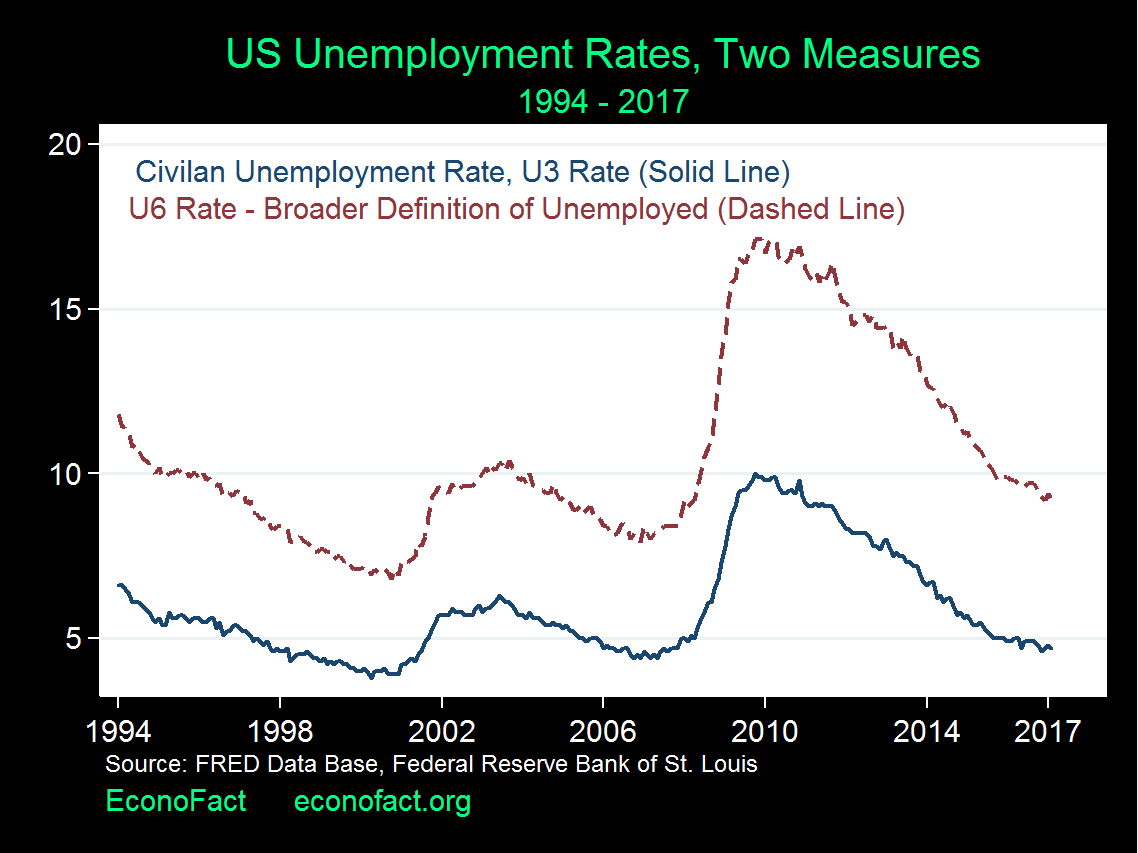Are Economic Statistics Fake News?
Wellesley College
The Issue:
Is the unemployment rate published by the Bureau of Labor Statistics a good gauge of the state of the labor market? The credibility of economic data produced by government statistical agencies increasingly has been called into question. Before becoming president, Donald Trump repeatedly criticized numbers from the Bureau of Labor Statistics’ monthly jobs report, referring to them as “phony” and “totally fiction.” He also has suggested that the unemployment rate could actually be above 40 percent. Such comments contribute to a skepticism about economic data among the public. Indeed, a Marketplace-Edison Research poll from October 2016 reported that 25 percent of Americans do not at all trust the economic data reported by the federal government. This is troubling because it reflects broader doubts of government legitimacy. Also, economic statistics are key tools for monitoring and tracking the economy, and it could be hard to build consensus on policies if the underlying statistics prompting those policies are called into question.Economic statistics play a critical role in understanding and tracking the economy as well as in setting policy.
The Facts:
- To count as unemployed someone must be out of work, be available for work, and have looked for work within the past four weeks. The unemployment rate is calculated by the Bureau of Labor Statistics (BLS), based on a monthly survey of about 60,000 households. Specifically, the official rate is the ratio of the number of people who are unemployed and actively looking for work to the size of the labor force. That measure of the unemployment rate (known as the U-3 measure and plotted as the solid navy line in the figure) has fallen substantially since the financial crisis. Over about the past year, this rate has hovered a little below 5 percent, close to the level that many economists believe is consistent with the economy performing up to its potential.
- There are legitimate critiques of the official unemployment rate, and many analysts have argued that it provides too upbeat a view of labor markets. One of these critiques is that part of the decrease in the unemployment rate in recent years reflects people dropping out of the labor force after unsuccessfully struggling to find work since an unemployed person dropping out of the labor force decreases the unemployment rate. Another issue is that people who would like to be working full time but can only get a part-time job are not counted as unemployed but are, in a sense, underemployed. Because these critiques are sensible and widely understood, the BLS also reports an alternative unemployment rate that includes these additional groups in the count of the unemployed. This alternative unemployment rate, known as the U-6 measure, is plotted as the dashed maroon line. It has remained well above the official rate in recent years, though—like the official rate—it has come down significantly since the financial crisis.
- Could the unemployment rate be above 40 percent, as President Trump claims? He has not said how that number was calculated, but here is a guess. Suppose everyone who is not working is counted as “unemployed,” including retirees, students, and stay-at-home parents. Counting all of these people as unemployed generates an “unemployment rate” that is much higher. Indeed, for February 2017, the ratio of everyone not working to the size of the adult population was 40 percent. This statistic, however, tells us very little about the state of labor markets because students, retirees, and stay-at-home parents are, for the most part, not working by choice rather than because the labor market is underperforming.
What this Means:
While there are legitimate critiques of the unemployment rate and other economic data, it is very corrosive to denigrate these statistics for political expediency. Carelessly undermining the credibility of economic statistics, or making claims about statistics that use questionable definitions to artificially exaggerate situations, makes public conversations about the economy and economic policy more difficult. Moreover, undermining these statistics by suggesting that they are phony could, in this time of budget stringency, fuel support for cutting budgets of the government agencies that produce them. Such cuts are short sighted because economic data play a critical role in understanding and tracking the economy as well as in setting policy. Scaling back the nation’s economic statistics could leave us flying blind – it would be like asking pilots and air traffic controllers to guide aircraft with the radar turned off.
Like what you’re reading? Subscribe to EconoFact Premium for exclusive additional content, and invitations to Q&A’s with leading economists.

